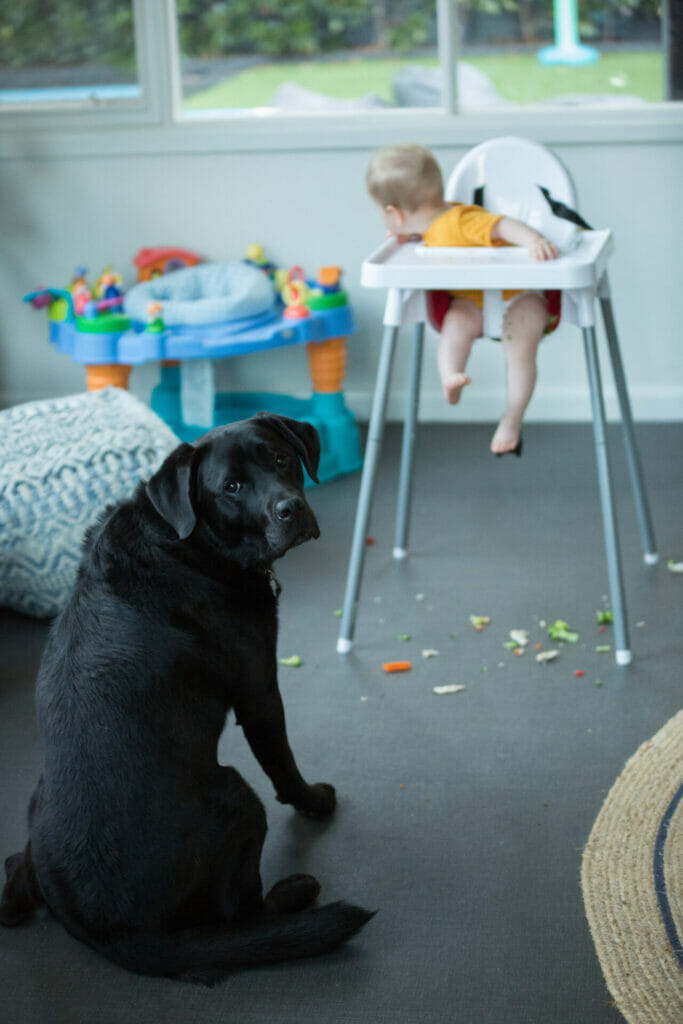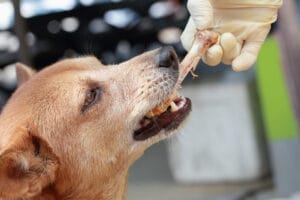If you have a young child, chances are your dog spends a lot of time under the highchair. While it may be convenient for your pup to sit under the highchair on clean-up duty, it’s a behavior you want to discourage. For dogs, being under and around the highchair when babies are eating is highly rewarding behavior because there is a steady supply of exciting treats being flung and dropped, so it can take a bit of training to get their attention focused elsewhere. Read more to learn how to discourage your pup from being a vacuum and foster a healthy and safe relationship between your dog and baby.
Why you should avoid having your dog under the highchair:
Although it might be cute for your dog to hang out under your child’s highchair and convenient to let your dog lick the floor, it’s important to discourage this behavior. To foster a safe and positive relationship between your dog and baby, you’ll want to supervise their interaction closely and not encourage your dog to see your baby as a food source. If your dog sees your child as a source of food, your dog will be more likely to try to steal food or become overly excited around your child, which can lead your pup to potentially knock down toddlers or small children to get to their food.
Prevention:
While having your dog clean up all the food the baby drops makes for cute content on social media, it’s not a behavior you want to encourage. The best way to stop your dog from being under the highchair and begging for food from babies and toddlers is to encourage your dog to be in another area of your home or kitchen during mealtime. If you have a door separating your dining or kitchen area, you can close your dog on the other side with plenty of toys or a chew. If closing a door is not an option, you can use a baby gate to prevent your dog from having access to the kitchen during the baby’s mealtime.
Another option is to put a dog bed in another area of your kitchen or eating space, then use treats and praise to reinforce your dog staying on their bed while your kids eat. Then, you’ll need to be diligent about cleaning up before releasing your dog back into the kitchen so they don’t come in and reward themself with treats left behind on the floor. This can take a lot of repetition and high-value treats and may be easiest when your kids are eating something lower-value.
Reward alternative behavior:
To stop our dogs from begging under high chairs, we don’t want to scold or punish, rather we want to use positive reinforcement tactics to reward the behavior we want. To do this at mealtime, bring your dog to the area of the house you would like them to be (e.g., on a bed or behind a door/baby gate) and give your dog a chew or a hard rubber toy like a KONG stuffed with (dog safe) peanut butter or other treats.

The high-value treat/chew will keep your dog occupied during the baby’s meal. If you do this consistently, your dog will quickly make the association that the baby in the highchair means they get a delicious treat in another part of the house away from the baby’s food. Behavior that gets reinforced is more likely to be repeated. By rewarding a behavior incompatible with being under the highchair, like laying on their bed, you will naturally shift your dog’s behavior at mealtime.
It’s important to teach dogs to be respectful around people eating food, including keeping your dog away from the highchair during mealtimes, keeping your dog from stealing food from children, and training your dog to not beg for food. To prevent this behavior and keep your dog away from the highchair, reward your dog for being in other areas of your home when it’s time to feed the baby (and make sure you have an excellent mop handy, we know under the highchair can get messy!).




















